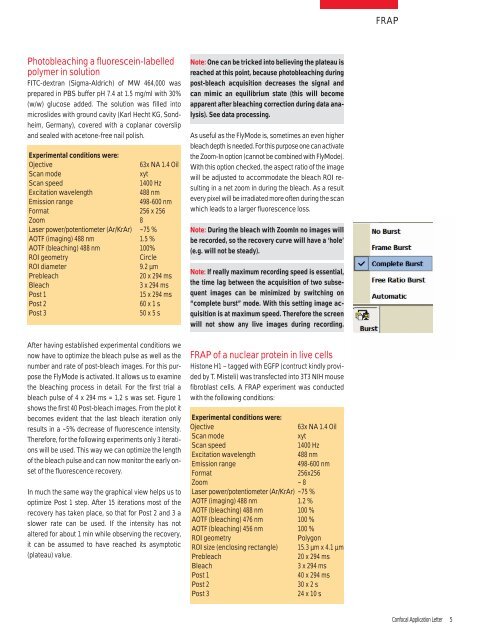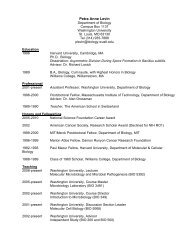Guide for doing FRAP with Leica TCS SP2 - Biocenter
Guide for doing FRAP with Leica TCS SP2 - Biocenter
Guide for doing FRAP with Leica TCS SP2 - Biocenter
You also want an ePaper? Increase the reach of your titles
YUMPU automatically turns print PDFs into web optimized ePapers that Google loves.
<strong>FRAP</strong>Photobleaching a fluorescein-labelledpolymer in solutionFITC-dextran (Sigma-Aldrich) of MW 464,000 wasprepared in PBS buffer pH 7.4 at 1.5 mg/ml <strong>with</strong> 30%(w/w) glucose added. The solution was filled intomicroslides <strong>with</strong> ground cavity (Karl Hecht KG, Sondheim,Germany), covered <strong>with</strong> a coplanar coverslipand sealed <strong>with</strong> acetone-free nail polish.Experimental conditions were:Ojective63x NA 1.4 OilScan modexytScan speed1400 HzExcitation wavelength488 nmEmission range498-600 nmFormat 256 x 256Zoom 8Laser power/potentiometer (Ar/KrAr) ~75 %AOTF (imaging) 488 nm 1.5 %AOTF (bleaching) 488 nm 100%ROI geometryCircleROI diameter 9.2 µmPrebleach20 x 294 msBleach3 x 294 msPost 115 x 294 msPost 260 x 1 sPost 350 x 5 sNote: One can be tricked into believing the plateau isreached at this point, because photobleaching duringpost-bleach acquisition decreases the signal andcan mimic an equilibrium state (this will becomeapparent after bleaching correction during data analysis).See data processing.As useful as the FlyMode is, sometimes an even higherbleach depth is needed. For this purpose one can activatethe Zoom-In option (cannot be combined <strong>with</strong> FlyMode).With this option checked, the aspect ratio of the imagewill be adjusted to accommodate the bleach ROI resultingin a net zoom in during the bleach. As a resultevery pixel will be irradiated more often during the scanwhich leads to a larger fluorescence loss.Note: During the bleach <strong>with</strong> ZoomIn no images willbe recorded, so the recovery curve will have a ‘hole’(e.g. will not be steady).Note: If really maximum recording speed is essential,the time lag between the acquisition of two subsequentimages can be minimized by switching on“complete burst” mode. With this setting image acquisitionis at maximum speed. There<strong>for</strong>e the screenwill not show any live images during recording.After having established experimental conditions wenow have to optimize the bleach pulse as well as thenumber and rate of post-bleach images. For this purposethe FlyMode is activated. It allows us to examinethe bleaching process in detail. For the first trial ableach pulse of 4 x 294 ms = 1,2 s was set. Figure 1shows the first 40 Post-bleach images. From the plot itbecomes evident that the last bleach iteration onlyresults in a ~5% decrease of fluorescence intensity.There<strong>for</strong>e, <strong>for</strong> the following experiments only 3 iterationswill be used. This way we can optimize the lengthof the bleach pulse and can now monitor the early onsetof the fluorescence recovery.In much the same way the graphical view helps us tooptimize Post 1 step. After 15 iterations most of therecovery has taken place, so that <strong>for</strong> Post 2 and 3 aslower rate can be used. If the intensity has notaltered <strong>for</strong> about 1 min while observing the recovery,it can be assumed to have reached its asymptotic(plateau) value.<strong>FRAP</strong> of a nuclear protein in live cellsHistone H1 – tagged <strong>with</strong> EGFP (contruct kindly providedby T. Misteli) was transfected into 3T3 NIH mousefibroblast cells. A <strong>FRAP</strong> experiment was conducted<strong>with</strong> the following conditions:Experimental conditions were:Ojective63x NA 1.4 OilScan modexytScan speed1400 HzExcitation wavelength488 nmEmission range498-600 nmFormat256x256Zoom ~ 8Laser power/potentiometer (Ar/KrAr) ~75 %AOTF (imaging) 488 nm 1.2 %AOTF (bleaching) 488 nm 100 %AOTF (bleaching) 476 nm 100 %AOTF (bleaching) 456 nm 100 %ROI geometryPolygonROI size (enclosing rectangle) 15.3 µm x 4.1 µmPrebleach20 x 294 msBleach3 x 294 msPost 140 x 294 msPost 230 x 2 sPost 324 x 10 sConfocal Application Letter 5











